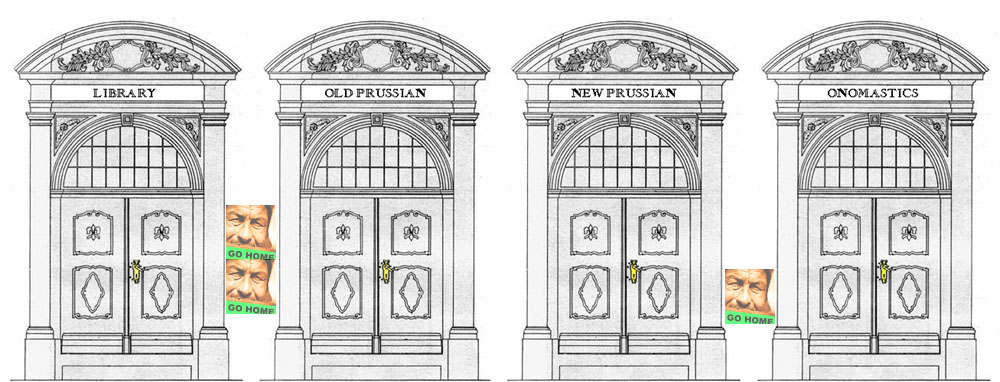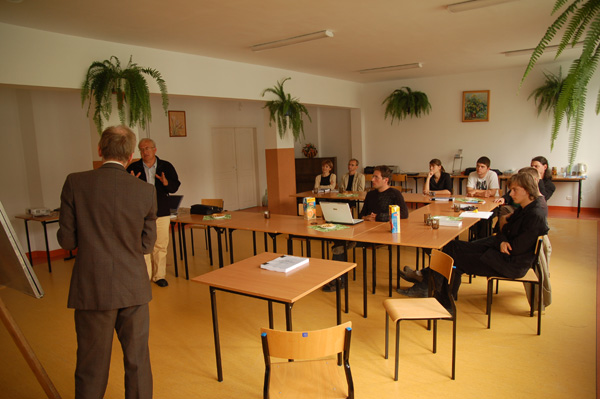

Old Prussian is a translation of German Altpreussisch meaning autochthon language of Baltic Prussia (historical West- and East-Prussia) conquered by the Germans in the 13th c. The term Old was incorrect until the emergence of New Prussian (revived Modern Prussian) in ourdays. This term came into being because the Germans comprehended Prussian as an older language of the Duchy of Prussia. Nevertheless the German dialects of West- and East-Prussia were not any Baltic Prussian language but were a local kind of Low German.
The Prussian language really belongs not to the Germanic but to the Baltic group of Indoeuropean languages and is cognate with living Lithuanian and Latvian languages. The Baltic group of languages in its turn is closest to the Slavic group of languages (Czech, Serbian, Polish, Russian etc.). The latter, together with the Baltic group, are closest to the Germanic group of Indoeuropean (German, English, Swedish etc.). The Germanic languages are so-called centum-languages (cf. the word Engl. Hundred, Latin Centum), while the Baltic and Slavic languages are satem-languages (cf. Lith. Šimtas ‘hundred’, Polish Sto, Avestian Satæm). The Baltic languages in their turn are divided into Western (or Peripheral) Baltic (Prussian, extinct Yatvingian, Old Curonian etc.) and Eastern (or Central) Baltic (Lithuanian, Latvian). The first have retained e.g. an older diphthong ei on the place of the newer ie in the latter. On the other hand, Prussian shares with Latvian the whistling pronounciation of sibilants (s, z) against their hushing pronunciation in Lithuanian (š, ž), all of them coming from “centum” Indoeuropean *k, *g. Prussian is much more archaic than Eastern Baltic, although Lithuanian is much more archaic than Latvian.
Old Prussian, extinct since the beginning of the 18th c., is known in toponyms, lists of personal names and in written monuments: the 802 words Elbing Vocabulary (manuscript of the 13th/14th c.), small Grunau’s Vocabulary (beginning of the 15th c.), fragmental texts, 3 printed Lutheran Catechisms (1545, 1545, 1561 – short prayers and the whole M. Luther’s “Enchiridion”). The last edition of Prussian written documents is "Prūsų kalbos paminklai" by V. Mažiulis (Vilnius 1966).
The Catechisms reflect several dialects of Samland with the long *ā (as in Latvian) formally corresponding to Common Baltic *ā reconstructed by the linguists. The Elbing Vocabulary with its long *ō (as in Lithuanian) on the place of this *ā reflects some Pomezanian dialect.
Click here for some trends in Reconstructing Prussian.
Modern Prussian is on a stage of revivification. Currently a version based on Samlandian dialect of the Catechisms (Mikkels Klussis, cf. also Principles on page 'New Prussian' below) is spread among Baltic Prussian groups in Lithuania (Prāncis Arellis, Vytautas Rinkevičius), the region of Kaliningrad (Glabbis Niktorius), in Polish Warmia-Mazurland (Nērtiks), in Latvia (late Dailūns Russinis) and even among Baltic-Krivian groups in Belarus (Alis Mikus). At the same time a version based on Pomesanian of the Elbing Vocabulary (Mikkels Klussis, Valdis Muktupāvels) is used for sacred and poetic texts only.

Debates in Prussian with Maciej Piegat in Górowo on 26 August, 2006
Parallel to these versions there have been attempts of Günter
Kraft-Skalwynas (Germany) and Maciej Piegat (Poland). The language of G. Kraft, a productive author of many New Prussian texts, is an
inconsequent mixture of Old Prussian (Samlandian and Pomesanian often not
unified), Lithuanian and Latvian words. Nevertheless it is unambiguously
recognisable as Baltic Prussian. This cannot be said about M. Piegat's one which
lacks differentiation of length in vowels and is a kind of individual Esperanto
on the basis of Prussian. We invite M. Piegat to revise his language on
linguistic grounds and to contribute to revification of Pomesanian Prussian. One
attempt more is of Joseph Pashka in Arisona U.S.A. He named his language
Sudovian, nevertheless it should be named a kind of idealised linguistic
reconstruction of Prussian because it lacks typical features of Samlandian
Sudovian, as attested in the Catechisms with all probability (see an article of
2001 by L. Palmaitis on page 'Library' > Publications > Books and
Articles). The language of J. Pashka is worthy
of further experimentation since there is no differentiation between a-stem
nominiative and genitive singular (both being -as) in it, as in Hittite.
In this case there may be no accusative in this language but the structure
should be so-called "active" one of Common Indoeuropean (and Common
Baltic, of course), maybe similar to Kartvelian languages (Georgian, Mingrelian,
Svan).
What a version should be used, depends on a concrete aim. If one aims to revive
a realistic continuation of the language of the Catechisms, then the version by
M. Klussis seems to be optimal and should be perfected. If one aims to create a
local vernacular for people accustomed to Slavic in Poland, then the version of
M. Piegat may suit, although the Balts will never recognise it Prussian or
Baltic. If finally one aims to create a specific language for inner experimental
communication between linguists Indoeuropeanists and Baltists, then the language
of J. Pashka may appear to be very interesting.
This site represents Modern Prussian by Mikkels Klussis. Here you find also samples
of his spoken Prussian recorded by Glabbis Niktorius in
2005.